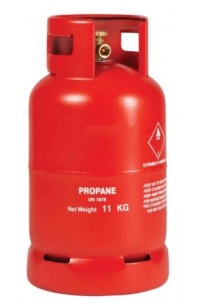Complete Powerpoint slide presentation for forklift instructors. Ready made training course
Liquified Petroleum Gas Properties and hazards
Liquefied Petroleum Gas properties
 Liquefied Petroleum Gas or LPG for short, is actually a mixture of about 90% Propane and 10% Butane when used in engines such as those on fork lift trucks. Some, cheaper, forms of LPG have a higher ration of Propane: up to 70% in some parts of the world! It was first produced in 1910 by Dr. Walter Snelling in the USA.
Liquefied Petroleum Gas or LPG for short, is actually a mixture of about 90% Propane and 10% Butane when used in engines such as those on fork lift trucks. Some, cheaper, forms of LPG have a higher ration of Propane: up to 70% in some parts of the world! It was first produced in 1910 by Dr. Walter Snelling in the USA.
LPG has a very low boiling point of minus 42 centigrade so that when released from it's cylinder at normal temperatures it instantly vaporises. Trucks using these systems have petrol engines fitted and the "carburetor" fitted to these engines only needs to meter the gas as it has already been vapourised! As a result, a very simple form of carburetor can be fitted to LPG systems that requires little maintenance.
The occupational hazards of propane fuel.
Exposure to high levels of propane fuel occurs generally only while filling tanks or from a leak from the tank or fuel delivery system. Propane gas is heavier than air; therefore leakage from a vehicle parked or stored near an unventilated pit or a lower level room is a hazard.
Brief exposures to concentrations of propane up to 10,000 parts propane per million parts of air (ppm) do not cause any symptoms in humans. Exposures to very high concentrations of propane (100,000 ppm) can produce slight dizziness after a few minutes of exposure. At extremely high concentrations (several hundred thousand parts per million), propane acts as an asphyxiant by displacing oxygen. This means one could suffocate if exposed to high enough concentrations of propane because it dilutes the oxygen in the air.
There have only been a very few studies of accidental overexposure to propane; victims reported symptoms of disorientation, excitation, headache and vomiting.
Propane gas is very flammable and should be considered as a fire hazard.
The hazards of propane combustion products.
Complete combustion of propane results in the formation of carbon dioxide and water vapour. Carbon monoxide is a by-product of combustion when there is not enough oxygen to burn the propane completely.
Carbon monoxide and carbon dioxide are hazards when propane-powered equipment is used in enclosed, poorly ventilated areas. Symptoms of carbon monoxide and carbon dioxide overexposure include headache, fatigue, dizziness and nausea. Carbon monoxide is a toxic gas that interferes with the ability of the red blood cells to carry oxygen. Exposure to very high concentrations of carbon monoxide, (more than 4,000 ppm), can result in coma or death.
Because carbon dioxide is an asphyxiant gas, exposure to extremely high concentrations, (above 100,000 ppm), can result in death. Such life-threatening concentrations are very unlikely to occur in most workplace situations. However, symptoms of headache, fatigue and dizziness may show that there is inadequate ventilation in the workplace. The frequency of complaints of these symptoms increases as the carbon dioxide levels increase above 800-1,000 ppm.
Ccontrolling exposure to propane and its combustion products.
Regular maintenance, tuning of propane-powered engines and inspection of vehicle exhaust systems for leaks keep the exposure to a minimum.
To control exposure to propane during refueling the generally recommended procedures include:
- storage, refilling and handling of liquid propane fuel by qualified or trained personnel, and
refueling or exchanging removable propane cylinders outdoors or in well ventilated areas, away from sources of ignition. - The refueling area should be equipped with a fire extinguisher.
When using propane-powered equipment indoors, ensure that there is adequate ventilation in the workplace. Some jurisdictions recommend specific ventilation rates. Some countries have recognised the dangers and have even specified the rate at which air should be purified in terms of X cubic feet per minute.
Download HSE factsheet relating to bulk LP Gas storage.